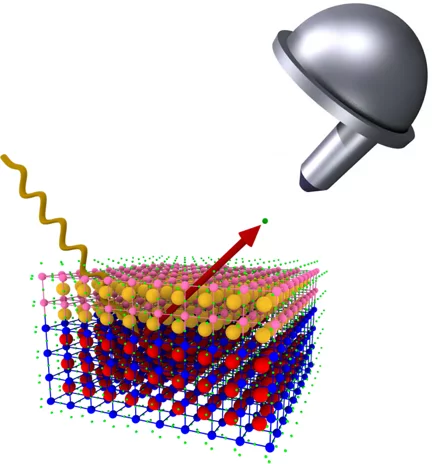Exotic phenomena at interfaces of complex oxides are highly promising for future solid-state electronics applications. A prominent example is the interface of two wide band gap insulators formed by growing a LaAlO3 layer on TiO2-terminated SrTiO3 substrate. When the LaAlO3 thickness exceeds 3 unit cells this system undergoes a sharp insulator-to-metal transition with a two-dimensional electron gas (2DEG) appearing at the interface. A team of scientists from the Paul Scherrer Institute and University of Geneva, Switzerland, has investigated the LaAlO3/SrTiO3 interface with photoelectron spectroscopy. The researchers have for the first time unambiguously directly detected the 2DEG signal at the Fermi level with its sharp onset between the insulating and conducting interfaces. Furthermore, they determined the spatial localization depth of the conducting sheet. The problem of absorption and inelastic scattering of the photoelectrons as they pass through the LaAlO3 overlayer was solved by using advanced synchrotron-based instrumentation delivering a high photon flux, and operating in the soft-X-ray energy range where the photoelectron escape depth increases. Furthermore, in consequence of the very small number of electrons in the 2DEG, their photoelectron signal was boosted by tuning the photon energy to resonant excitation of the core electrons, through a Fanolike process. This work represents a significant methodological advance in resonant photoemission spectroscopy of buried interfaces.
Read the full story
Read the full story
Original publication
Interface Fermi States of LaAlO3/SrTiO3 and Related HeterostructuresC. Cancellieri, M. L. Reinle-Schmitt, M. Kobayashi, V. N. Strocov, T. Schmitt, P. R. Willmott, S. Gariglio and J.-M. Triscone
Phys. Rev. Lett. 110, 137601 (2013), DOI: 10.1103/PhysRevLett.110.137601
Contact
Dr. Claudia Cancellieri; Swiss Light SourcePaul Scherrer Institut, 5232 Villigen PSI, Switzerland
Phone: +41 56 310 5689, e-mail: claudia.cancellieri@psi.ch
